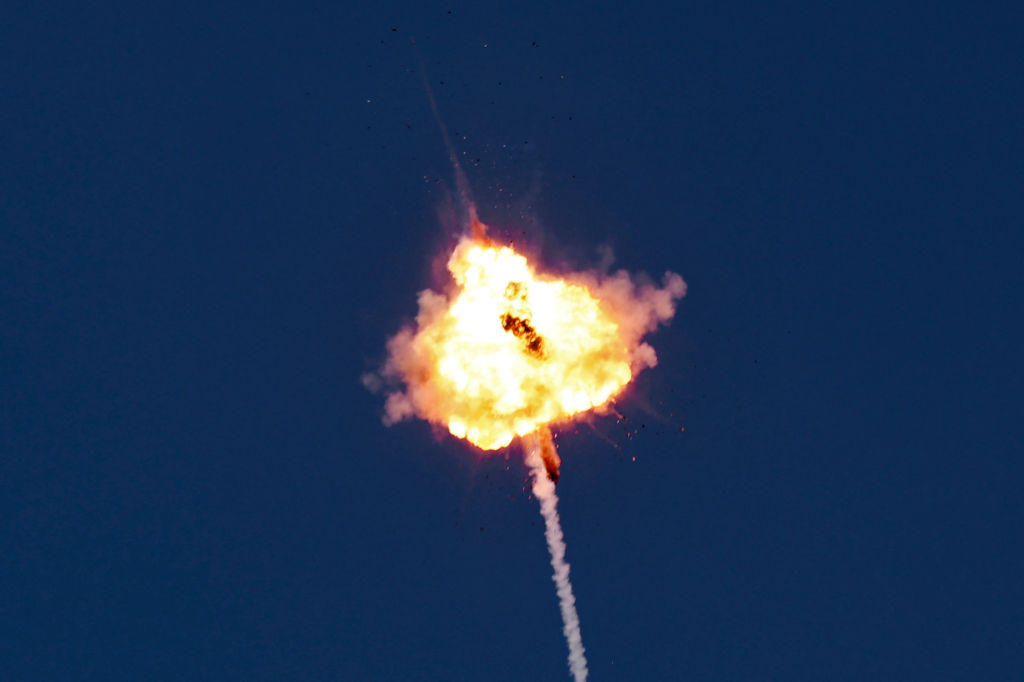Air defence was in the news this week, after Israel, with the help of allies including the UK, shot down around 99 per cent of over 300 cruise and ballistic missiles and drones fired at it by Iran. The perils of depleted air defences were shown by Russian missile and drone bombardments of Ukrainian energy infrastructure and cities, leading again to many civilian deaths. Eighteen civilians were killed in a Russian strike on Chernihiv.
In the wake of the Iranian attacks, Tobias Ellwood, former chair of the House of Commons Defence Committee, told the Telegraph that the UK needs to build ‘a permanent umbrella of security defending our key locations’. This required, he said, ‘investments, absolutely, in an Iron Dome’ – our own version of Israel’s highly effective missile system. Ellwood is wrong. This is the last thing we should do.
Defending every square inch of UK is both militarily impracticable, and would be financially ruinous.
The UK faces a very different air defence dilemma than Israel. For one, the UK is 11 times bigger. There are 75 widely dispersed UK cities with a population greater than 100,000; Israel has 15 such cities concentrated in the centre of the country. The UK is also located on the western extremity of Europe, affording it both strategic depth and allied protection against attacks from the east. Israel has recognised since 1949 that it lacks any strategic depth.
Crucially, the UK faces a very different type of air threat than Israel. Iron Dome was originally designed to counter waves of short-range rockets fired against Israeli cities by Hamas and Hezbollah. It has now evolved to deal with drones. The UK does not face a similar rocket threat. The type of cheap, slow-moving drones fired at Israel and used in Ukraine would take many hours to reach the UK, giving ample time to get our defences in order together with our Nato allies. Russian ballistic missiles similar to those used by Iran this week cannot reach the UK. Russia would also be unwise firing ballistic missiles at a nuclear-armed state.
In truth, the main air threat against the UK remains the same as it was during the Cold War, albeit at a lesser scale: long-range Russian cruise missiles fired by aircraft, ships or submarines from the north. These missiles are designed to implement Russia’s well-known strategy, as seen in Ukraine, to attack key political, military, economic, transport, or communications targets to deter, defeat, dissuade, or dishearten its opponent.
The UK’s ability to deal with these air threats has reduced dramatically since the disappearance of the Soviet Union in 1991. Today, we lack the layered air defence system to comprehensively defend the UK from the renewed Russian missile threat. A senior UK officer told Parliament in February this is a recognised operational risk.
UK capability to deal with these missiles is not all bad. Royal Navy Type 45 destroyers will be upgraded over the next decade. The Royal Air Force will soon take possession of new Wedgetail surveillance aircraft. RAF Typhoon and Lightning II jets are formidable air-to-air assets. In 2021, the British Army took possession of the advanced medium-range Sky Sabre system, which incorporates Israeli know-how. The UK has formed a Missile Defence Centre, is upgrading its shore-based radars, and is collaborating with allies on new detection and interception technologies. The accession of Finland and Sweden to Nato also complicates Russia missile planning.
The Ministry of Defence, however, acknowledged last year that it still needed to ‘step up’ its efforts to deliver integrated air and missile defence for the UK. This will mean further investment in sensors, command and control, data links and the offensive systems that can destroy the ships, aircraft, and submarines of any adversary before they launch missiles against the UK. Or, in defence slang, destroying the archers before they can loose their arrows. It will mean investment in the resilience of critical infrastructure, dispersal of vital assets, and hardening of key UK bases as part of a nascent National Defence Plan. As a senior expert at the Rusi think tank noted this week, this also means ‘more missile ammunition and funded flying hours’ for the RAF to practice air defence against cruise missiles before they get anywhere near the UK.
Defending every square inch of UK is both militarily impracticable, and would be financially ruinous. The vast majority of Iranian missiles and drones were shot down before they reached Israeli airspace. This is where the balance of air defence investment should be, combined with additional Sky Sabre systems to deal with, in the parlance, any ‘leakers’ heading towards particularly vulnerable civilian or military locations. These systems could also be upgraded with longer-range missiles or sensors.
Targeting any enemy offensively while shoring up our own defences will make any air attack less likely to succeed, also contributing to deterrence by denial by changing an adversary’s risk-reward calculation. This will be a wiser investment than in Iron Dome, a system focused on an unlikely threat to the UK.







Comments